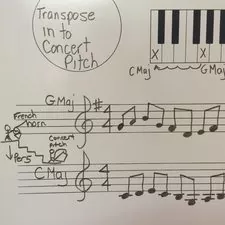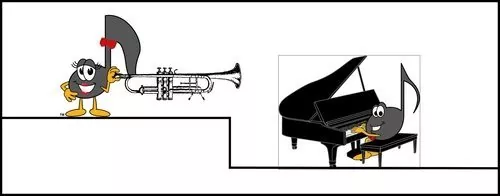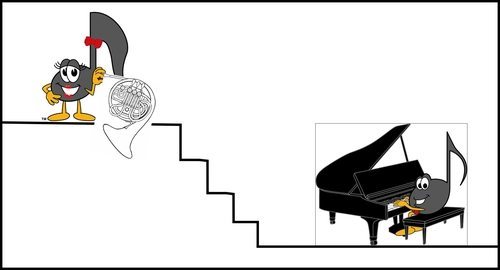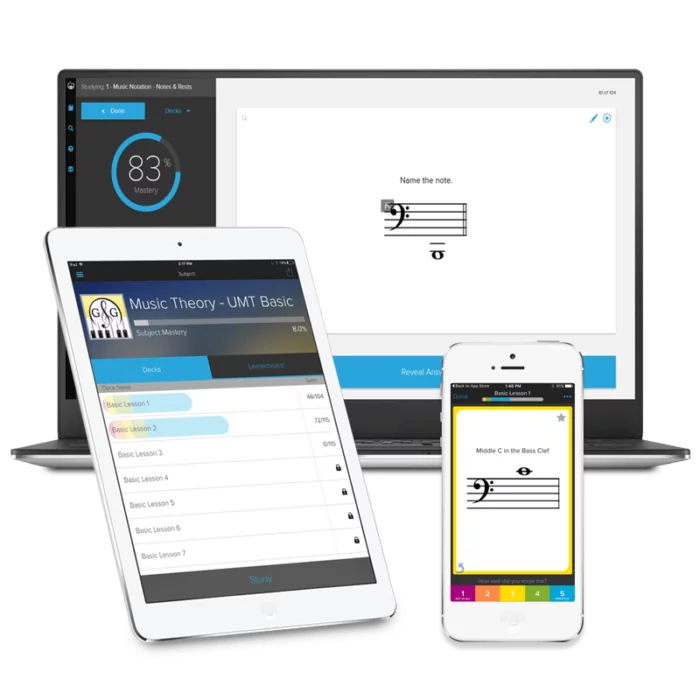Understanding Concert Pitch

Understanding Concert Pitch
Understanding Concert Pitch was a bit of a challenge for me. Growing up, I was not lucky enough to have had the opportunity to learn other instruments - my focus was the piano. So when it came to Concert Pitch, I was lost.
When an instrument plays a "C" in their score, shouldn't it always match the C pitched on the piano? I just didn't "get" how different instruments could play a "C" in their music, but it sounded like a different note - definitely not C!
Transposing in to Concert Pitch was something that I just guessed at...until several years ago when I purchased and completed Glory St. Germain's first edition of the Ultimate Music Theory Workbooks. In her Advanced Workbook, when she explained Concert Pitch - I GOT IT! (One of these days I will definitely have to blog on how Glory and I finally met!)
Concert Pitch is simply an interval of transposition so that all instruments can play the same music at the same pitch. Glory's memory joggers had me (finally) remembering the interval of transposition in to Concert Pitch.
Being dyslexic (and constantly mixing up right/left and up/down directions) how could I remember (and remind my students) of the direction of the transposition? So I came up with some tips to help me.
Just in case there are some teachers who struggle with this too, I thought I would share my tips for Concert Pitch with you.
There are instruments that play a C and it sounds like a C on the piano. These are called Concert Pitch Instruments and include the Flute, Oboe, Bassoon, Trombone and the Piano!
Concert Pitch and B-flat Instruments
We also have "B-flat instruments" - the Clarinet and the Trumpet for example.
My good friend and fellow Ontario Music Teacher Deb Miller-Cushon explains it like this:
"I've always found it helpful to say to my students for a B-flat instrument, the musician sees "C" in their score, they finger and play "C" on their instrument and we all hear a B-flat. So you take the score for a B-flat instrument and, to write it out for a piano or other C instrument (in other words, to write it out in Concert Pitch), you move it down a Major 2nd. Then both instruments will be playing the same pitch - the trumpet with the original score and the piano with the transposed score."
Now that makes sense to me!
Having strong Visual Learner tendencies, I helped myself remember how to teach this concept by drawing this "picture" for my students (my picture uses stick people - that is what is featured in the picture above - okay, art has never been my forte! LOL).

For B-flat Instruments: So-La is play the Trumpet (a B-flat instrument) up on the stage. Ti-Do is playing the piano (a Concert Pitch instrument) down in the Concert Pit. (Get it - you have to go down into the Concert PIT to play in Concert PITCH and you have to transpose DOWN to get into Concert Pitch!)
Using your Concert Pitch B-flat Instrument Memory Jogger that you learned on Page 104 in the Advanced Rudiments Workbook, we realize that transposing in to concert pitch for a B-flat Instrument is as simple as transposing down a Major 2. Cool, eh?
Concert Pitch and F Instruments
We also have "F instruments" - the English Horn and the French Horn in F are two examples. When they play a C in their score, it sounds like an F on the piano. Therefore, for the English Horn or French Horn to play in Concert Pitch, the music must be transposed down a Perfect 5.

For F Instruments: So-La is play the French Horn (an F instrument) up on the stage. Ti-Do is playing the piano (a Concert Pitch instrument) down in the Concert Pit. (Get it - the solo instrument is up on the stage, the concert pitch piano is down in the pit.)
Using your Concert Pitch F Instrument Memory Jogger that you learned on Page 105 in the Advanced Rudiments Workbook, we realize that transposing in to concert pitch for an F Instrument is as simple as transposing down a Perfect 5.
Concert Pitch Question
I love receiving questions from Teachers. Recently, a teacher emailed me and asked: "Can Concert Pitch be written in either clef? If the test gives a transpose into concert pitch from French horn and is written in the Treble Clef, does it have to be transposed into the Treble Clef as well?"
So - after reading this Blog on Concert Pitch, what would your answer be?
While you are thinking, I want to encourage you to work through the Ultimate Music Theory Workbooks yourself. Now that we have the Complete Rudiments Workbook, this is the perfect opportunity to review your own theory foundation.
If you buy the Complete Workbook (and Answer Book) and you do every page - top to bottom - completing all exercises (and marking all exercises using your Complete Answer Book), and you do not learn one single thing, I will refund you your money.
And now, the answer: The use of different clefs makes it easy to write music for all instruments and voices specific to their range. Instruments have a preferred clef in order to avoid using lots of ledger lines. In the Advanced Rudiments Workbook on Page 106, we have a chart showing the written range for Orchestral Instruments:

When transposing in to Concert Pitch, you will use the Clef given for your original melody. That way, both instruments will be playing the same music at the same pitch in the same clef.
If the given melody is in the Alto C Clef and the instructions say "The following melody is written for Trumpet in B-flat. Transpose in to Concert Pitch.", you will transpose the given melody down a Major 2nd in the Alto C Clef.
If the given melody is in the Bass Clef and the instructions say "The following melody is written for French Horn in F. Transpose in to Concert Pitch.", you will transpose the given melody down a Perfect 5th in the Bass Clef.
If you have ever had some confusion understanding Concert Pitch, I do hope that this Blog has helped you! Remember - if you ever had a question, please ask! Your questions are often the inspirations for these Blogs.
- LEARN FASTER – Use on any device, phone, tablet, computer
- EXPLORE – Identify written & audio notation
- PLAY – Sight Reading and Ear Training Games and much More!
Students will LOVE hearing exact pitch and pronunciation of terms.
Students will be INSPIRED to use their imagination while building a foundation in Ear Training and Sight Reading.
The One and ONLY Music Theory App & Matching Workbook!
Keep on Learning... With a Smile and a Song!
Shelagh McKibbon-U'Ren



I vaguely remember sitting on my father’s knee while he went over the orchestra score. (yes he was a maestro of a major orchestra in Amsterdam Netherlands) and seeing all the different clefs for different instruments and him also explaining the concert pitches. Thank you for refreshing my memory. Aimee
Thanks for sharing your tips Shelagh. Such an easy way to explain and remember.